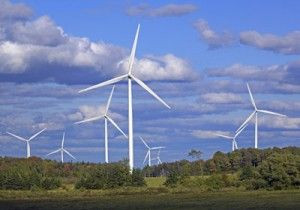Sky's No Real Limit For Wind Power, Scientists Say

While social and economic forces may keep humans from relying solely on wind power, natural forces will not be a limit, a pair of scientists claims.
Four million wind turbines in an all clean-energy economy in 2030 could supply enough to meet more than half the world's energy demand, according to Stanford researcher Mark Jacobson and University of Delaware scientist Cristina Archer.
Previous studies have argued that turbines would steal too much energy from each other to be useful on a grand scale. But in a new study published in the Proceedings of the National Academy of Sciences on Monday, Jacobson and Archer developed a weather model they say counters these claims.
Jacobson and Archer used software to create a simulation that separates atmospheric winds into little virtual boxes stacked atop one another. They looked at the amount of wind energy that could be harvested 10 meters above ground, the height of most wind turbines, and 10 kilometers in the air - where the jet streams are.
They found that while there are saturation points after which additional wind turbines will not be able to harvest more energy, the turbines do not 'rob' each other until huge numbers of turbines are installed - more than we would ever need, according to the researchers.
"The bottom line is there is sufficient wind to power half -- or even many times half -- of the world's energy for our purposes," Jacobson said in a phone interview.
In their paper, the researchers estimate that 4,000,000 five-megawatt turbines operating at 100 meters could generate as much as 7.5 terawatts of power - more than half of the world's demand. There's also much more wind power to be tapped, hypothetically. Jacobson and Archer calculated that installing wind turbines across the entire surface of the Earth would yield 250 terawatts each year. Even if turbines were only placed on six of the seven continents (sorry, Antarctica), there would be 80 terawatts available each year.
Harnessing the jet streams -- which, admittedly, we still aren't sure how to do -- could yield another 380 terawatts per year, Jacobson and Archer wrote.
But where to put the wind farms?
"If they're close together, the interference reduces productivity, so you do want to spread the wind farms apart," Jacobson says.
There are lots of many places across the globe that would be good candidates for big wind farms: on the Great Plains, or off the east coast of the U.S., the Gobi desert in Asia, and out in Australia, according to Jacobson.
"The careful siting of wind farms will minimize costs and the overall impacts of a global wind infrastructure on the environment," he said in a statement. "But, as these results suggest, the saturation of wind power availability will not limit a clean-energy economy."
SOURCE: Jacobson et al. "Saturation wind power potential and its implications for wind energy." PNAS published online 10 September 2012.
© Copyright IBTimes 2025. All rights reserved.





















